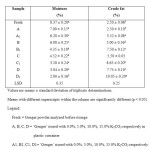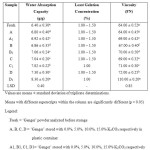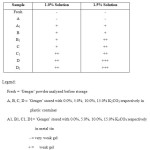Introduction
Natural gums are polysaccharides of natural origin, capable of causing a large viscosity increase in solution, even at small concentrations.1 In the food industry they are used as thickening agents, gelling agents, emulsifying agents, and stabilizers. In other industries, they are also used as adhesives, binding agents, crystal inhibitors, clarifying agents, encapsulating agents, flocculating agents, swelling agents and foam stabilizers.2 Most often these gums are found in the woody elements of plants or in seed coatings and are edible in different forms.3
There are many types of edible gums, such as Gum Arabic, Gum Tragacanth, which are complex mixture of glycoproteins and polysaccharides and are used in confectionery to gel or to set liquids to various degrees of viscosity.4 Edible gums like xanthan gum and gelatin are used to thicken and or hold emulsions together in a food system such as a sauce. Many other types of edible gums have similar or slightly different uses in processed foods. For example, gums can help to hold moisture into injected meats. Many of these gums are used along with starches.5
In many cultures in the developing countries (especially Africa), there exists a number of traditional foods, which are swallowed without mastication. Such foods include the popular pounded yam, akpu, amala and other types of food prepared and molded from tubers and roots such as yam and cassava as well as cereals like maize, sorghum and millet. Such foods are usually swallowed with the aid of viscous slippery soups and stews (edible gums), generally referred to ‘draw soups’, which aid peristalsis. Examples of such soups include: okra, ewedu, okoho, ager and ive which are consumed in different parts of Nigeria. One of the very popular ‘draw soups’ in Tiv land is genger, a soup (edible gum) prepared from the calyx of the flowers of the plant Bombax costatum,6 the flowers of which when fully developed, consist of red petals fused into a round calyx, which is attached to the stalk of the plant.
Genger soup, which is a delicacy in the Tiv speaking area of central Nigeria, has high viscosity or gelling capacity from November to February/March (dry season) depending on how soon the rains come. During this period, it can be produced from either the fresh or dried calyx, the latter of which can be stored for future use, when the plant stops producing flowers. However, as soon as the rains start, the soup from the dried calyx powdered genger loses its gelling properties and viscosity.6 This has been attributed to high moisture content7 as a result of absorption of moisture from the atmosphere. When this happens, genger becomes inedible and is therefore wasted.
Oral communication (Hannah, A. D. Nyakuma, 2010) indicates that storage of genger powder inside dark coloured polyethylene bags in air – tight containers with addition of kaunwa or potash (Potassium carbonate) helps to maintain its gelling capacity, even during the rainy season.
Potassium carbonate (K2CO3) also known as potash or pearl ash is a white salt, soluble in water (insoluble in ethanol), which forms a strongly alkaline solution. It can be made as the product of potassium hydroxide’s absorbent reaction with carbon dioxide. It is deliquescent, often appearing as a damp or wet solid. Potassium carbonate is used in the production of soap, glass and china.8 Today, potassium carbonate is prepared commercially by the use of potassium chloride. The resulting potassium hydroxide is then carbonated using carbon dioxide to form potassium carbonate, which is often used to produce other potassium compounds.9
2KOH + CO2 → K2CO3 + H2O
Potassium carbonate is used in reactions to maintain anhydrous conditions without reacting with the reactants and product formed. It may also be used to dry some ketones, alcohols, and amines prior to distillation.8 In the laboratory, it may be used as a mild drying agent where other drying agents, such as calcium chloride and magnesium sulfate, may be incompatible. It is not suitable for acidic compounds, but can be useful for drying an organic phase if one has a small amount of acidic impurity.9
The objective of this work, therefore, was to determine the changes in the viscosity and related physico–chemical properties of genger (Bombax costatum) soup prepared from dried calyx powder stored with varying quantities of potassium carbonate (K2CO3).
Materials and Methods
Source of raw materials
Fresh flowers of Bombax costatum (December, 2010 harvest) were collected from a tree in the University of Agriculture, while potash (Potassium carbonate), low density polyethylene bags and air tight plastic containers were purchased from a local chemical shop in Makurdi. Empty metal tins were collected from a residential home in Makurdi.
Sample preparation
The fresh calyxes were removed from the flowers, washed clean with tap water and sun dried to a moisture content of about 10.0%. The dried calyxes were then milled into powder using an attrition mill (Asiko AII) and analyzed immediately .Thereafter, two sets of four samples of the powder (100g each) were blended with varying quantities of potassium carbonate (0.0g, 5.0g, 10.0g and 15.0g) to give 0.0% (control) 5.0%, 10.0% and 15.0% respectively. The samples were then stored inside dark – coloured low density polyethylene bags at ambient conditions (30 – 350C) for four months (May – August). While one set was stored in an air tight plastic container (samples A, B, C, D), the other set was stored in an air tight metal tin (samples A1, B1, C1, D1), from where samples were taken for analysis.
Analyses
Physico – chemical analysis:
Moisture and crude fat contents were determined by the method of AOAC.10 While Least Gelation Concentration (LGC) was determined by the method described by Onweluzo et al.,11 Water Absorption Capacity (WAC) was determined using the method described by Okezie and Bello.12 The viscosity of the samples was determined using the Falling Number method as described by Sultan.13 In this method, twenty grams (20g) of genger sample was suspended in distilled water in a 250ml measuring cylinder, immersed in a boiling water bath and stirred for exactly 60 seconds. A plunger (7g mass) was then allowed to fall freely through the suspension in a fixed distance and the falling time (FT) was recorded. Falling time (FT) is the time in seconds for the plunger to fall through the fixed distance.
FN = FT + 60 (Where: FN = Falling number, 60 = a constant).
Statistical Analysis
Data obtained was analyzed statistically using analysis of variance (ANOVA) at 5% probability level as described by Steele and Torrie.14 Where significant difference existed, Tukey’s Test was used to separate the means as described by Ihekoronye and Ngoddy.15
Results And Discussions
Chemical properties
Results of the chemical properties determined are presented in Table 1. There was a decrease in moisture content of the genger powder with storage and increase in quantity of potassium carbonate (K2CO3) from 8.30% in the fresh sample to 3.00% and 2.00% in samples D and D1 (with 15% K2CO3).Among the samples themselves, moisture content decreased from 7.00% to 3.00% in sample A to D (samples stored in plastic) and from 6.00% to 2.00% in A1 to D1 (samples stored in metal tin). This could be as a result of absorption of moisture from the genger powder by potassium carbonate (K2CO3).
 |
Table 1: Some Chemical Properties of Fresh and Stored ‘Genger’ (Bombax Costatum) Powder.
|
Leonard et al.9 postulated that potassium carbonate could be used in reactions to maintain anhydrous conditions without reacting with the reactants and product formed.
There was a significant difference between the samples themselves at (p < 0.05) but no significant difference (p > 0.05) between the storage containers. Moisture content affects the viscosity of fluids. The higher the moisture content, the lower the viscosity and lower the moisture content, the higher the viscosity. This is ascribed to decrease in polymer concentration.7
The crude fat content of the genger samples increased significantly (p < 0.05) with storage from 2.50% in the fresh sample to 7.50% and 10.05% in samples D and D1 respectively. This could be as a result of concentration effect occasioned by the reduction in the moisture content of the samples. There was also a significant (p < 0.05) increase in the fat content of the samples themselves, with values ranging from 2.50% to 7.50% for samples A to D and 3.50% to 10.05% for samples A1 to D1 This could be attributed to the drying action of the potassium carbonate. Fat is a necessary component of living tissues and essential in human nutrition. Because it can be stored and be mobilized, it is the prime reserve material for the body.16
Physical Properties
Table 2 presents the results of some physical properties of fresh and stored genger samples. The water absorption capacity (WAC) increased with storage from 6.40g/g in the fresh sample to 7.30g/g and 8.30g/g in samples D and D1 respectively. There was also an increase in WAC with increase in potassium carbonate (K2CO3) with values ranging from 6.80g/g to 7.30g/g for samples A – D and 6.92g/g to 8.30g/g for samples A1 – D1.
 |
Table 2: Some Physical Properties of Fresh and Stored ‘Genger’ (Bombax Costatum) Powder. |
This is expected because as the samples become drier as a result of storage with K2CO3, there is a greater tendency to absorb water. There was however, no significant difference (p > 0.05) in water absorption capacity between the samples themselves and the packaging materials. Water absorption capacity represents the ability of a product to associate with water under conditions where water is limiting. In food processing, a high water absorption capacity results in a product with excellent body, smooth, fine texture and chewiness capacity especially in ice cream.17
The viscosity of the genger samples increased significantly (p < 0.05) with storage and increase in concentration of potassium carbonate (K2CO3). While the viscosity increased from 64.00FN in fresh genger sample to 72.00FN and 110FN in D and D1 respectively, it increased from 64.00FN to 72.00FN in samples A – D and from 69.00FN to 110.00FN in samples A1 – D1, thus showing a better viscosity in samples stored in metal tin. This could be as a result of the decrease in moisture caused by storage with K2CO3. Wang et al.7 reported that the viscosity of fluids increases with decrease in moisture and decreases with increase in moisture. Viscosity or internal friction or resistance to flow is the key factor in distinguishing between the different types of fluid systems and is an important factor in the organoleptic acceptability of food products.19
Table 3 shows the effects of storage and potassium carbonate (K2CO3) on the gelation concentration of genger powder. In all the samples the least gelation concentration (LGC) fell between 1.0 and 1.5% of sample. Table 3 shows the effects of storage and potassium carbonate (K2CO3) concentration on the gel strength of the genger samples.
 |
Table 3: Gel Strength of Fresh And Stored ‘Genger’ (Bombax Costatum) Powder. |
The gel strength generally increased with storage and K2CO3 concentration. While the samples with 15.0% K2CO3 (D and D1) formed stronger gels with 1.50g samples, D1 gave the highest gel strength, thus indicating that storage in metal tin was better. Least gelation concentration is useful in predicting the texture of a food product.18
Effect of Storage Container
It can be observed from the results that in all the parameters measured, the samples stored in the metal tin returned better results than those in the plastic container. This could be because of the better protective barrier (better sealing) offered by the metal tin, thus preventing any leakage of moisture into the medium.
The results obtained from this study show that while the moisture content and gelation concentration of genger (Bombax costatum) powder decreased with storage and increase in potassium carbonate (K2CO3) concentration, the viscosity, crude fat, water absorption capacity and gel strength all increased significantly (p < 0.05). These changes were all more pronounced in the samples stored in the metal tin as compared to those in the plastic container. This implies that storage with potassium carbonate can be effectively used to preserve the viscosity of genger for use throughout the year, thus preventing wastage. Though the optimum concentration of potassium carbonate to be used is yet to be determined, it is clear that metal tins are better than plastic containers for storage.
Acknowledgements
We wish to express our profound appreciation to the Head of Department and staff of the Department of Food Science and Technology for laboratory facilities and assistance in carrying out the various analyses involved in this study. WE also wish to acknowledge Mrs. Hannah Ann Dzertomom Nyakuma for the oral communication and assistance with the storage studies.
References
- Iwe M.O., Obaje P.O. and Akpapunam M.A., Physico – chemical properties of cissus gum powder extracted with the aid of edible starches. Plant Foods Hum. Nutr.59 (4), 161 – 166 (2004).
CrossRef - Onweluzo J.C., Obanu Z.A. and Okwandu M.C., Potentials of gums from Detarium microcarpum (DM) and Mucuna flagllipes (MF) seeds as raw beef burger stabilizers. Plant. Foods Hum. Nutr. 54 (4), 137 – 141 (2004).
CrossRef - Mahfoudhi N., Chouaibi M., Dousi F., Ferrari G. and Hamdi S., Chemical composition and functional properties of gum exudates from the trunk of the almond tree (Prunus dulcis). Food Sci. Technol. Int. 18 (3), 241 – 250 (2012).
CrossRef - Rinsky L.H. and Rinsky G., The Pastry Chef’s Companion: A Comprehensive Resource Guide for the Baking and Pastry professional. John Willey & Sons, Chicester, 1 – 34 (2009).
- Hulse J., Flavours and \edible Gums: Opportunities for Integrated Agro-forestry Systems. Conference on Domestication and Commercialization of Non – Timber Forest Products in Agro – forestry Systems, Nairobi, Kenya, (1996).
- Tingir N. J., Proximate composition and functional properties of ‘genger’ an important soup material of Biddle Belt states of Nigeria. B. Sc Thesis, University of Agriculture, Makurdi, Nigeria, 1 – 7 (2003).
- Wang S.M., Bonvier J.M. and Gelus M., Analysis of Food nutrients. Int. J. Food Sci. Technol. 25, 137 – 141 (1990).
- Wikipedia., The Free Encyclopedia. En.wikipedia.org/wiki/Potassium carbonate (2013). Accessed: 24/04/2013.
- Leonard J., Lygo B. and Procter G., Advanced Practical organic Chemistry. Stanley Thomas Publishers Ltd., New York, (1998).
- AOAC., Official Methods of Analysis 15th Ed. Association of Official Analytical Chemist, Washington D.C., (2005).
- Onweluzo J.C., Obanu Z.A. and Onuoha K.G., Certain functional properties of gums derived from some lesser known tropical legumes. Plant Foods Hum. Nutr. 48, 55 – 63 (1995).
CrossRef - Okezie B.O. and Bello A.B., Physiochemical and functional properties of winged been flour and isolate compared with soy isolate. J. Food Sci. 53, 450 – 454 (1983).
CrossRef - Sultan W.J., Practical Baking, 5th Ed. Van Nostrand Reinhold Publications, New York, 1 – 24 (1990).
- Steele R.G.D. and Torrie J.H. Principles and Procedures of Statistics, 2nd Ed., McGraw- Hill Book Co Inc, New York, (1990).
- Ihekoronye A.I. and Ngoddy P.O., Integrated Food Science and Technology for the Tropics. Macmillan Publishers Ltd, London and Basingstoke, UK, 249-252 (1985).
- Gordon M. W., Perspectives in Nutrition, 4th Ed. Mc Graw Hill, 75 – 372 (1999).
- Giami S.Y. and Bekerbain, D.A., Poximate composition and functional properties of raw and processed full – fat fluted pumpkin seed (Jelfairia occidentalis) flour. J. Sci. Food Agric. 72, 321 – 325 (1992).
CrossRef - Iwe M.O., The Science and Technology of Soybean: Chemistry, Nutrition, Processing and Utilization, Rejoint Communications Service Ltd Enugu, 115 – 123(2003).
- Alfa J., Chukwu A. and Udeala O.K., Cissus stem gum as potential dispersant in pharmaceutical liquid systems: rheological characterization. Boll. Chim. Farm. 140(1), 20 – 27 (2001).

This work is licensed under a Creative Commons Attribution 4.0 International License.





